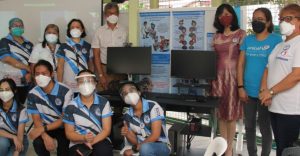
Abused children being trapped inside their homes are among the most tragic impacts of the pandemic. Apart from the abuse, children also experience the physical and psychosocial effects of the lockdowns.
“For the first time in the past 24 years, we had so many patients who were suicidal and needed intensive psychotherapy and medication,” PGH Child Protection Unit (CPU) Head Dr. Bernadette Madrid said.
The Child Protection Network (CPN) Foundation and UNICEF swiftly responded by developing a new system to ensure that child protection services are continued despite the restrictions of the pandemic— the TeleCPUs in the Barangay. Through telemedicine and 39 barangay-based teleCPU satellites, abused children can go to the nearest barangay and have access to teleconsultation and specialty services available only in tertiary care centers.
A computer set, webcam, headphones, and internet connection were provided to the partner barangays by the UNICEF. Barangay personnel were also oriented in telemedicine and underwent training in child protection with help from partner agencies including World Health Organization, United Nations Population Fund, Dept. of Social Welfare and Development, Philippine National Police, and Women and Child Protection Units.
“We are very lucky that all of these barangays welcomed this project and wanted to participate. They saw the value of bringing the services of PGH to the locality through an innovative manner such that without being physically present in PGH, the services can be delivered,” said Dr. Madrid, also the CPN Executive Director and the woman behind the TeleCPU Center sa Barangay project.
In time with the World Day for Prevention of Child Abuse observed every November 19th, the 39 barangays in Cavite and NCR participated in the event through Zoom and joined the simultaneous ribbon-cutting that marked the opening of the teleCPUs.
There are teleCPU centers in Bacoor, Imus, General Trias, Dasmariñas, and General Mariano Alvarez in Cavite; and in Parañaque, Las Piñas, Pasay, Taguig, Malabon, Navotas, Caloocan, and Valenzuela in Metro Manila.
Transforming Child Protection
According to UNICEF Representative Mr. Behzad Noubari, the project has captured the interest of the global community because of how it transforms the way that child and gender-sensitive models are delivered even to isolated and far-flung areas in the country. “The teleCPU model that you have developed was shared with international partners and was showcased as a best practice in the adaptation of child protection services in the context of COVID-19.
“We hope that more local government units will be inspired by your experience and will commit to setting up their own Women and Child Protection Units and teleCPUs. We hope that the DOH will take this forward and support the scale-up of this adaptation to all regions,” he said.
Dr. Marianne Joy Maritana, the TeleCPU Center Project Officer, reported that since April 2021, 34 patients have been served through 60 successful teleconsultations. She emphasized that empowering the community to be part of child protection would help end child abuse in that area.
PGH Director Dr. Gerardo Legaspi commended the CPU for standing firm and resolute for the rights of children who need help. “Ang ating CPU ay humahanap ng paraan sa gitna ng limitasyon ng face-to-face na pagkokonsulta. Ang programang ito ay nagpapatunay na sa krisis na ito ay natuto tayo kung paano palawigin ang serbisyo.”
UP Manila Chancellor Carmencita Padilla acknowledged Dr. Madrid’s passionate and tireless work for not only establishing the Child Protection Units in the country but for creating ways to reach the children and their families during these times.
“Without a leader who will connect the rest of the network, we will not succeed. Ang mga barangay na kung hindi kasama ay walang magagawa ang telehealth sa PGH. Para maging matagumpay ito, dapat sama-sama tayo. Kung kayo ay may nakikita pang paraan upang mapaganda pa ang ating programa, ipaalam niyo agad sa PGH-CPU.”
The teleCPU program will be expanded in the Cordillera Administrative Region, Regions 7 and 11 with the DOH regional hospitals and WCPUs as hubs. Another 17 satellite areas are in the process of becoming fully operational in the NCR.
(This article, written by Anne Marie Alto, was first published in the UPM Website on November 2021)
